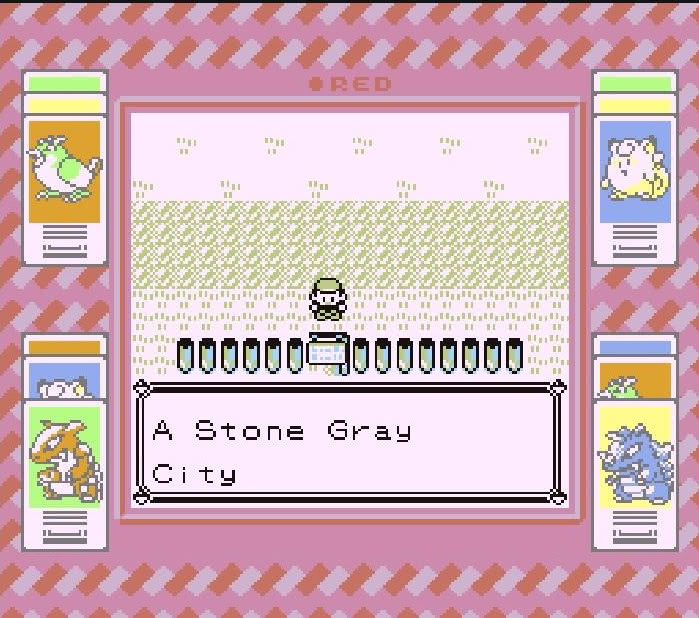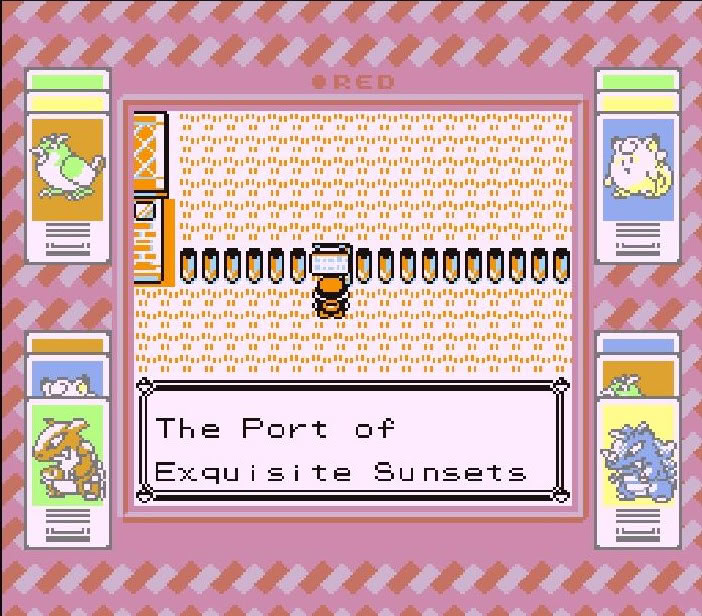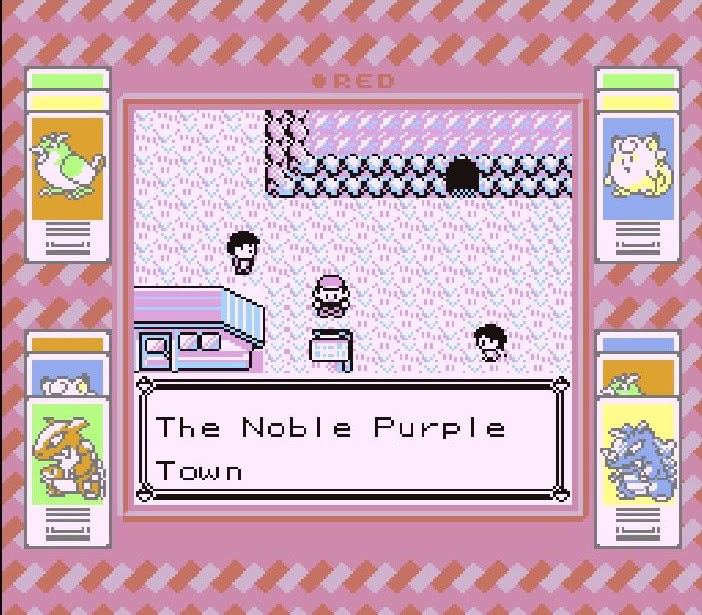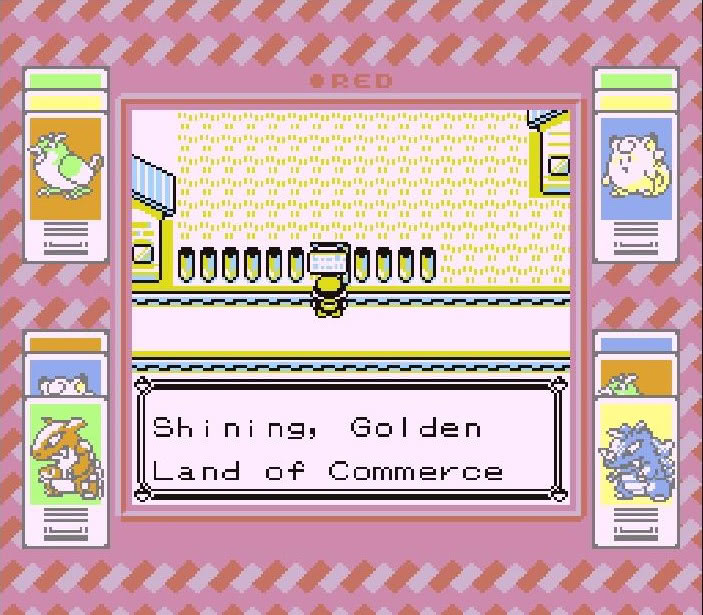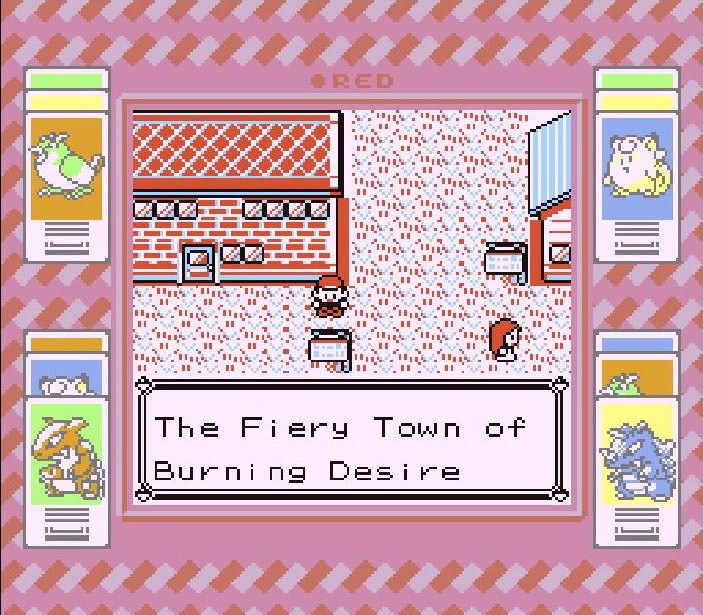One long-running tradition in the mainline Pokémon series is that every town has a short slogan. This tradition began with the generation I Pokémon games and continues with the most recent entries in the series, generation IX’s Scarlet and Violet. Back in 2020, I commemorated the 20th anniversary of the U.S. release of the generation II Pokémon games, Gold and Silver, with an article inspired in large part by the slogan of the player character’s home town, New Bark Town (I also explained how the New Bark Town slogan inspired our site slogan). Yesterday (September 28, 2023) marked the 25th anniversary of the U.S. release of the generation I Pokémon games, Red and Blue. I thought that it would be fun to commemorate the milestone with a look back at the original set of Pokémon town slogans.
Different Versions of Kanto Slogans
The generation I Pokémon games are set in a fictional version of Kanto. The game has 10 major towns and cities, each with a slogan. One thing that makes this survey interesting is that the generation I Pokémon games have appeared several times.
The original Pokémon Red and Green were released in Japan on February 27, 1996. They were followed in Japan by an improved Pokémon Blue version (first made available in a limited fashion in late 1996). The worldwide release (Red and Blue in the United States) is based on Japan’s Pokémon Blue. The series received a third edition in Pokémon Yellow. All of these games use the same set of town slogans in Japan and in the United States, respectively.
The generation II Pokémon games, Gold, Silver, and subsequently Crystal, have the player re-visit Kanto three years after the events of the first game. As we will see, some of the slogans in Gold, Silver, and Crystal are different than the generation I versions.
Both generations I and II received remakes. Generation I was re-made for Game Boy Advance in 2004 as Pokémon Fire Red and Leaf Green (Fire Red and Leaf Green are part of generation III). Generation two was re-made for Nintendo DS as Pokémon Heart Gold and Soul Silver in 2010 (Heart Gold and Soul Silver are part of generation IV). The re-makes modified town slogans from the originals in some cases. Finally, generation one was re-made in spin-off fashion for Nintendo Switch in Pokémon Let’s Go Pikachu and Pokémon Let’s Go Eevee in 2018, but these games usually use the same slogans as generation I (the Let’s Go duo is part of generation VII).
For each town, I will list all of the versions of the town slogans and offer my own assessment on which one is the best fit in cases where there are differences.
A Humorous Story to Start
My New Leaf Journal colleague Victor V. Gurbo has a mountain of old Pokémon Game Boy cartridges that I have temporary custody of. I wanted to include a picture of each Pokémon town sign that I am discussing in this article. Because I do not have a completed save on hand, I started trying Victor’s carts in my Game Boy Operator to find one with a finished game save (the reason I wanted a finished game is because that allows me to quickly access all of the towns to capture the necessary screenshots). After a few tries, I found Victor’s old Pokémon Red.
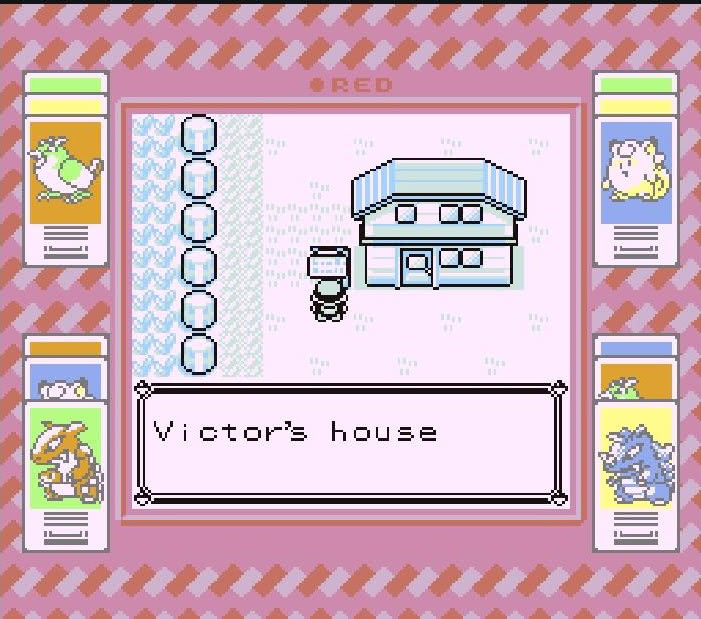
When I saw that his party consisted of a level 100 Mewtwo, Mew, Articuno, Zapdos, Dragonite, and Snorlax, I quickly deduced that he had relentlessly cheated with this copy. When I confronted him with this terrible offense, he said, and I quote:
That the Red one? Oh yeah. I had fun with that one.
Victor V. Gurbo
I could tell.
In any event, Victor had completed the game and his Articuno knew Fly, which effectively lets you warp to any town instantaneously. I began my screenshot journey.
Pallet Town
Pokémon games usually start in the player’s home town. In generation one, that location is called Pallet Town in the English versions.
There is not much going on in Pallet Town. It has a population of 10 and three whole buildings, with one of those buildings being the player’s house and another being the rival’s house. The most notable location is Professor Oak’s Lab where the player character selects his first Pokémon.
In the generation two games, Pallet Town is not the player’s home town. In those games, the player starts in New Bark Town in the Johto Region and passes through Pallet Town after having already become the Johto League Champion. But circumstances aside, generation two Pallet Town is largely similar to its generation one counterpart three years in the past.
It is a calm, quaint home location. What kind of slogan would fit?
| Gen | Pallet Town Slogan |
|---|---|
| Gen I/III/VIII | “Shades of your journey await!” |
| Gen II | “A Tranquil Setting of Peace and Purity.” |
| Gen IV | “A Pure White Beginning” |
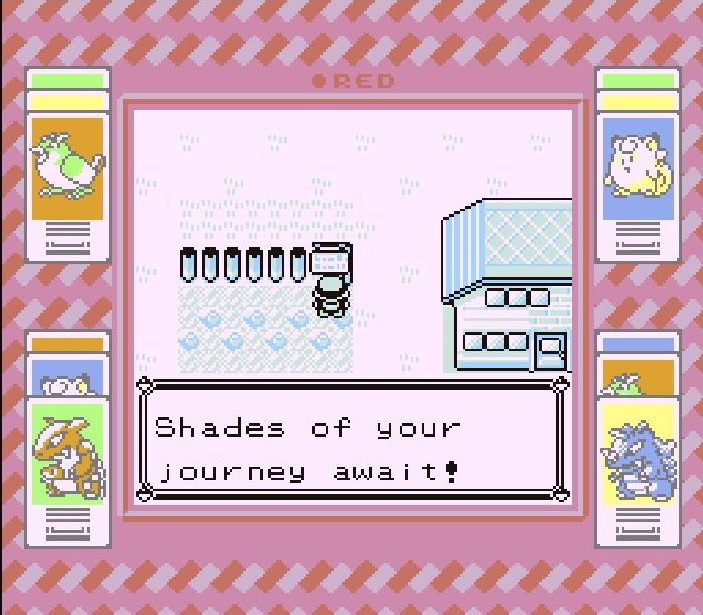
Pallet Town is one case in which it is worth looking at the Japanese games. All of the other towns in the English Pokémon games are named after colors. Pallet Town is the lone exception – although “Pallet” makes sense since it is the starting point for a journey through many colors. In Japanese, Pallet Town is Masara Town, which I understand would translate to White Town (you can see the legacy of the Japanese town name in the Game Boy Color color scheme for Pallet Town). The intent behind the White Town name is similar to Pallet Town, but it led to some divergent slogan choices in every generation save for four. See Bulbapedia’s translated slogans for the Japanese games:
- Gen I, III, and IV: “Masara is the color of pure-white beginnings.”
- Gen II: “Masara is colored pure white.”
- Gen IV: “The color of pure-white beginnings.”
I suppose the thought behind Masara Town is that you start with a blank slate and you will add color with your journey. Pallet Town suggests a similar idea of starting fresh and having potential to add color as you go along. The English slogan in Heart Gold and Soul Silver closely mimics the Japanese slogans, but it feels misaligned with the English town name.
Setting aside whether the Pokémon localization team made the right call in going with Pallet Town instead of White Town, we must consider which slogan works best for Pallet Town. To this effect, I must give the nod to generation one’s Shades of your journey await! The slogan captures the energy that many young Pokémon fans had about starting their Pokémon journeys after seeing the TV show debut slightly ahead of the game’s release. The Generation two slogan matches the feel of Pallet Town but lacks any connection to the town’s name. Generation IV would have the best slogan in a world where Masara Town was localized as White Town, but that is not the world we inhabit.
Viridian City
Viridian City is a small, pretty, and calm town that does not have much going on. However, it has a surprising number of occupants, coming in close to the middle of the pack thanks in part to its Gym and its trainer school. Of course, despite being the first Gym the player encounters, Viridian City is the final Gym the player clears (obtaining the other seven badges is a prerequisite). Viridian City, like The New Leaf Journal, is green (viridian is our site’s accent color).
Viridian City leans heavily into its name with its two slogans:
| Generation | Viridian City Slogan |
|---|---|
| I-III/VII | “The Eternally Green Paradise” |
| IV | “The City of Evergreen” |
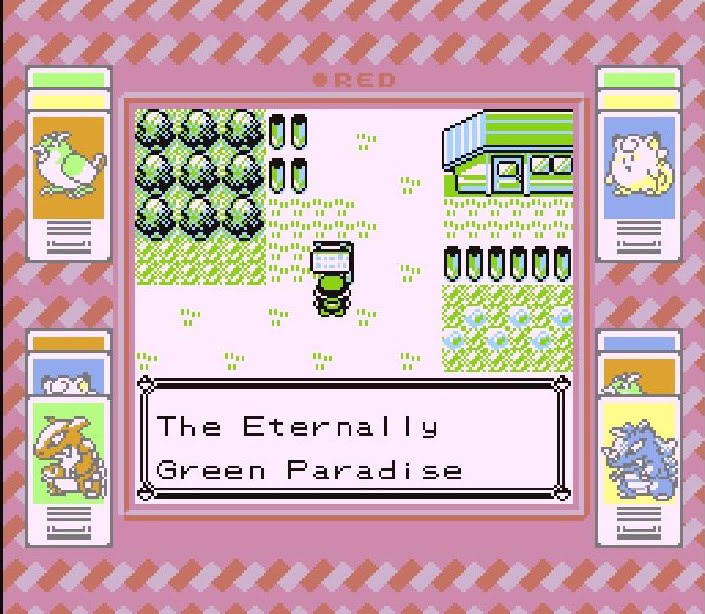
The slogans are similar. But of the options offered, Johto’s generation IV The City of Evergreen is the best slogan for Viridian City. The original slogan sounds too much like a travel brochure. However, the central idea behind both slogans proves fitting in light of the fact than other than a gym leader change, very little changes in Viridian City in three years.
Pewter City
After the tease that was Viridian City, young Pokémon trainers finally faced off against their first gym leader – Brock – in Pewter City. Pewter City, as its name suggests, has a gray, rocky theme – sitting close to the foot of Pokémon’s first proverbial dungeon, Mt. Moon. It feels bigger than Viridian City, but has slightly fewer town inhabitants. Its main attraction is a Museum, which in addition to being the coolest attraction introduced to the player early in the game (Viridian City’s Trainer School is not too exciting) gives the player the chance to add a few entries to the Pokédex.
Pewter is another location with a calm, slow-paced feel (and one of the Pokémon’s iconic background music tracks). Unsurprisingly, both of its slogan options play on the gray stone theme:
| Generation | Pewter City Slogan |
|---|---|
| I-III/VII | “A Stone Gray City” |
| IV | “Between Rugged Mountains” |
The first three generations get the better of the Pewter City slogan. A Stone Gray City is not too exciting, but neither is Pewter City. It fits the location and hews to Pokémon’s color theme. The generation IV slogan forgets the color theme, which is a major offense in my view. Moreover, while I do not doubt that Pewter City is between mountains, the only mountain we know the name of is Mt. Moon. That is one mountain.
Cerulean City
Cerulean City is my personal favorite Pokémon location in generation one. It sits on the other side of Mount Moon across from Pewter City. As one may expect given its blue name and theme, it is a sea-side city. To the northwest sits Cerulean Cave (aka the Unknown Dungeon) where the player can encounter the highest level Pokémon in Kanto (and Mewtwo in all generations except II) after clearing the main story. To the northeast is Cerulean Cape, one of the prettiest locations in Pokémon and the source of a few Pokémon urban legends.
The Cerulean City Gym is led by Misty, who is one of Ash’s traveling companions in the first couple seasons of the anime. In the game, however, she is just a regular Gym Leader (and the youngest of the eight in gen I, but old enough to go on Cerulean Cape dates in generation II).
I expect some water-themed slogans:
| Generation | Cerulean City Slogan |
|---|---|
| I-III/VII | “A Mysterious Blue Aura Surrounds It” |
| IV | “The Floral Lagoon City” |
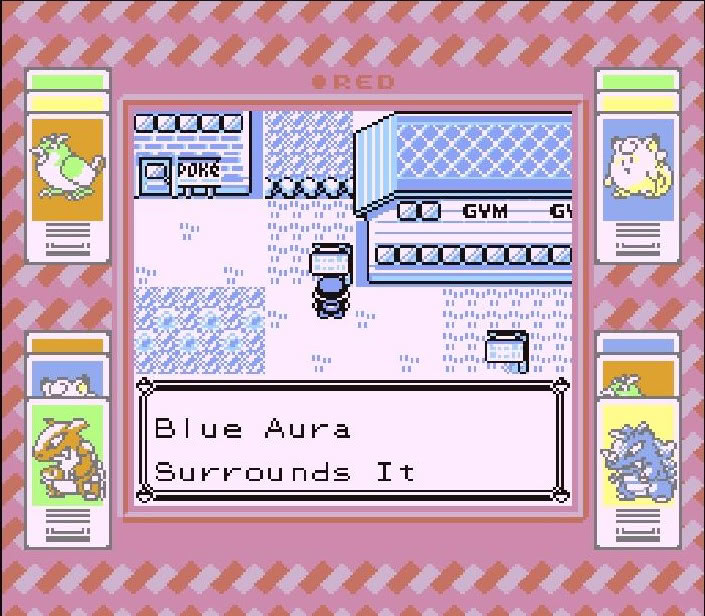
The generation I slogan is a bit odd. Bulbapedia translates the corresponding Japanese slogan as Hanada is the color of aqua mysteries. I am not sure that A Mysterious Blue Aura was the way to go – although I can see the logic. Although generation IV does not specifically use color (see my faulting it for that with Pewter City), its slogan is decent here since Lagoon suggests water. Moreover, Cerulean City does have large flower patches which this slogan draws attention to, making it the only slogan likely to make a player notice something that he or she may have missed otherwise.
With that being said, I think Cerulean City could have a better slogan. Even something simple like The City Of Crisp Blue Water or Fresh Blue Water would have worked better than the generation I pick.
Vermilion City
Vermilion City has an odd name on first glance. It is surrounded by water like Cerulean City to its north, but water plays an even larger role here since Vermilion City is a port city and its main initial attraction is a cruise ship called the S.S. Anne. Its gym leader, Lt. Surge, is an electric-type gym leader, which suggests yellow. Yet the City is named Vermilion City, which is a reddish-orange color.
Vermilion City has a workmanlike feel with its main business being a port. Other than the port, its main attraction is the Pokémon Fan Club and a construction site. Let us see how it uses its theme and color to make a slogan:
- All Generations: “The Port of Exquisite Sunsets.”
The Vermilion City slogan is the only one that never changes. I can see why. If you are going to name a port city Vermilion, focusing on sunsets is the way to go. This slogan perfectly captures both the location and the name.
Lavender Town
Lavender Town, like Pallet Town, does not have a Pokémon Gym. It does have an iconic (arguably creepy) theme song. The town is dominated by Pokémon Tower, which is actually a multi-story Pokémon cemetery with many ghost Pokémon (and the ghost of a Pokémon) floating around. Lavender is a good color choice for it given the mood and the fact that the only ghost-type Pokémon in generation I are purple. It must have a good slogan:
| Generation | Lavender Town Slogan |
|---|---|
| I-III/VII | “The Noble Purple Town” |
| IV | “The Noble Town” |
Those choices are a little bit underwhelming.
Noble is a fair description for Lavender Town. Pokémon Tower is one of the most striking structures in Kanto and an iconic location in the generation I Pokémon games. The town also has a traditional feel that would be very at home in generation II. Both of the slogans are fine, albeit not inspiring. In this case, I think Generation IV has the better of it since noble suggests purple without needing to explicitly add it.
Celadon City
Celadon City sits at the cross-roads of the second half of Pokémon generation I (the first three gyms make up the first part of the game). From Celadon City the player has easy access to a big chunk of the map. Although Saffron City (coming soon) is touted as the biggest city in Kanto, Celadon City has the largest population and the most going on. It features a Department Store with many unique items, a large condominium where the player can talk to video game versions of the Pokémon development team, a casino (which shockingly was a cover for a Team Rocket hideout in generations I, III, and IV), and a hotel.
Celadon is the highest-energy City in Kanto, but it is not my favorite because it does not have a strong sense of self (maybe there is just too much going on). Its color is interesting in that it matches the feel of the gym leader but not the town. Celadon City’s gym leader is the pretty, understated, and kimono-clad Erika, who specializes in grass-type Pokémon (she also has the same name in English and in Japanese). Celadon is a shade of grayish-green, which matches her grass type, and it strikes me as a color with a traditional feel, which matches Erika’s attire and manner. But does it match a bustling City with Kanto’s only casino? I am not so sure. Let us see the slogans:
| Generation | Celadon City Slogan |
|---|---|
| I-III | “The City of Rainbow Dreams” |
| IV | “City of the Rainbow’s Colors” |
| VII | “City of Rainbow Dreams” |
Rainbows have little to do with celadon that I am aware of, but Erika does hand out the Rainbow Badge – so I suppose that is something. This is the first case wherein the generation VII Let’s Go games diverge from generation I, albeit one would have to squint to notice.
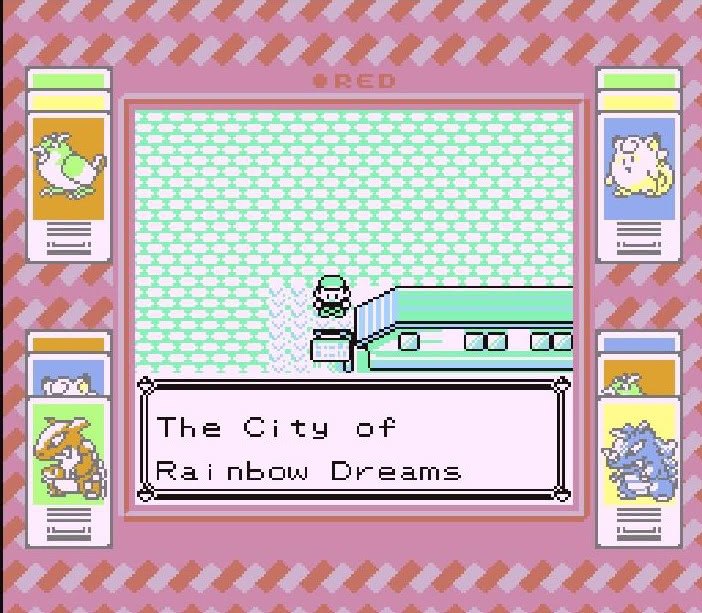
Generation IV’s slogan does not fit since it draws our attention to the fact that the slogan is ignoring celadon. Given the choice, I will take the generation I-III slogan. Celadon City is a city of many possibilities and easy to travel to and from, so dreams fits in that sense. Ideally, the slogan should have contemplated Celadon City as a place where the traditional (Erika’s Gym, the hotel) and modern (the department store, game corner, and condominium) come together and live side-by-side.
Fuchsia City
Fuchsia City is one of the more interesting locations in Kanto. It has a traditional Japanese feel (more obvious in later renditions, it would have been at home with Celadon as its color) and interesting amenities in a Pokémon Zoo (my favorite attraction as a kid) and the Safari Zone. Sadly, there is not much happening besides the Zoo and the Safari Zone, but it is neat on the whole. Fuchsia City also sits in an interesting location with easy access to water which offers the best surfing route to the Seafoam Islands.
(Note: The Safari Zone was made inaccessible in generation II due to cartridge space concerns, but it was brought back in the generation IV remakes.)
Fuchsia’s Gym Leader adds to its traditional feel (unlike the minor clash I noted with Erika in Celadon City). Koga is an older man in ninja attire. While fuchsia may seem like an odd color choice, Koga specializes in poison type Pokémon. This is also the only Gym other than Viridian City which has a different Gym Leader three years in the future. Koga’s daughter, Janine, is the (very under-leveled) Gym Leader in generations II and IV. Where is Koga? He earned a promotion to the Elite Four.
But what about the slogans?
| Generation | Fuschia City Slogan |
|---|---|
| I-III/VII | “Behold! It’s Passion Pink!” |
| IV | “Happening and Passing City” |
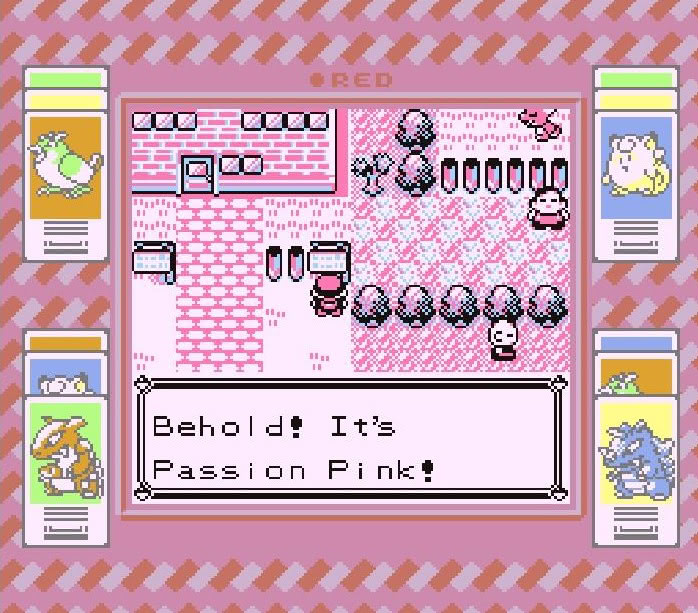
What in the world? These are both absurd. Fuchsia City is not passion anything and happening and passing has no meaning. I cannot pick between these. They both dropped the Safari Ball.
Bulbapedia translates the Japanese slogan as Sekichiku is the color of pink flora. While that is hardly inspiring, it would have been a better starting point that yelling at me about passion pink.
(Maybe it could have used some cherry blossoms?)
Saffron City
While Pokémon did an admirable job making Vermilion City work for a port city, Saffron would have been perfect there. Saffron is yellow, matching the electric-type gym leader, and it is the sort of spice that is a luxury trade item, fitting the port theme.
But no one asked me what to name the cities.
Saffron City is modeled after Tokyo and is touted as the biggest city in Kanto, albeit we already established that the honor goes to Celadon City. Its dominant attraction is Silph Co., a technology company which produces an item needed to see ghosts in Lavender Tower. In the generation I games, Sliph Co. is taken over by Team Rocket, leading to one of the more memorable events on the player’s journey.
Saffron City is unique in that it has two gyms, although only one is official. The official gym leader is Sabrina, who is presented as maladjusted, powerful, and dangerous in the anime. The only thing her game counterparts have in common with her anime version is that they both use psychic Pokémon and have psychic powers. Game Sabrina is a sweet young woman. The unofficial gym is a fighting dojo, which anyone with rudimentary knowledge of Pokémon types knows is not a good match-up against Sabrina (especially in generation I wherein psychic Pokémon had no real checks). While they cannot give you a badge, they do give you a Hitmonlee or Hitmonchan (both of which are much better in generation II).
(I will note that when one thinks psychic Pokémon, one thinks purple – but I guess both purple locations were already taken – and the Elite Four sits at Indigo Plateau, which is almost purple.)
Saffron City changes notably in generation II with the addition of a Magnet Train, which connects Saffron City to the biggest city in Johto, Goldenrod City (I see what they did with the color matching). There are a few other fun things in Saffron City, but one notable aspect is that it has enough housing to accommodate all of its inhabitants (fun fact from Bulbapedia).
What did they do with the slogan?
| Generation | Saffron City Slogan |
|---|---|
| I, III, VII | Shining, Golden Land of Commerce |
| IV | Shining Big City |
I do not understand the original commerce-focused slogan. Sliph Co certainly sells things, but the player cannot buy them. It is presented more as a tech company than a mall. If anything in Kanto is a “shining, golden land of commerce,” it is Celadon City, not Saffron City. Saffron City only hosts an ordinary Poké Mart. Now contrast with Bulbapedia’s translation of the Japanese slogan: Yamabuki is the color of golden radiance. I do not know what happened with the localization. Maybe they consulted the Libertarian National Convention or something.
Generation IV’s Shining Big City is a fine, replacement-level slogan. Shining at least nods at yellow and I suppose that shining and yellow are a decent fit for a city modeled after Tokyo. One issue here is that Saffron City, like Celadon City, lacks a strong sense of self. It is a big city, but a hard one to put a color on. Moreover, unlike Celadon City, it does not really lean into its gym leader with its color choice (albeit Celadon City ignored that entirely with its slogan).
(Fun aside: Saffron City was used as a stage in the original Super Smash Brothers.)
Cinnabar Island
No location in Kanto has a name that better matches it than does Cinnabar Island. Here we have an island built around a large volcano. The Gym Leader is Blaine, who specializes in Fire-type Pokémon. This one really had to be some sort of red.
No Pokémon location changes more in three years than does Cinnabar Island. In generation I it is small but lively. In addition to Blaine’s Gym, it features a Pokémon Lab (where you can revive two fossils) and a burnt out mansion (which ties into Mewtwo’s backstory).
(It is also home to what is perhaps the most infamous glitch in all of video games, the MissingNo. glitch).
In generation II and IV, Cinnabar Island is home to a Pokémon Center and nothing else. What happened? The volcano went boom and destroyed all of the buildings except one. At least you can still heal your Pokémon, I suppose. Thanks to his Gym being destroyed, Blaine sets up shop on the somewhat nearby Seafoam Islands in generations II and IV. Despite the fact that Blaine is not present on Cinnabar Island in the return trip to Kanto, the player initially encounters Blue, who was the rival (and briefly Pokémon Champion) in the first games but is the Viridian City Gym Leader three years in the future.
For obvious reasons, the slogans for Cinnabar Island will not be a one-to-one comparison.
Or will they?
| Generation | Cinnabar Island Slogan |
|---|---|
| I-III | “The Fiery Town of Burning Desire” |
| IV | “The Ravaged Town of the Past” |
Interesting.
Pokémon Gold and Silver left the generation I slogan alone despite the fact that Cinnabar Island had been wiped away (the same is true in the Japanese versions). Generation IV, on the other hand, adopted a somber, hopeless slogan reflecting Cinnabar Island’s destruction.
Cinnabar Island’s initial slogan is decent, but nothing special. It accounts for color, Cinnabar Island’s volcano, and the gym. I do not associate passion with Cinnabar Island since one of its attractions is a wrecked mansion and its gym leader is an older man who likes quizzes, but the slogan checks the most basic boxes.
While the generation IV slogan accounts for Cinnabar Island effectively being no more, I do not much like it. Why would the people staying behind on or passing through Cinnabar Island choose that slogan? I would have preferred a forward-looking slogan if it must change. However, I think generation II made a fair choice in keeping the generation I slogan as a testament to the Cinnabar Island that was.
Indigo Plateau
Indigo Plateau is not a town, but instead the home of Victory Road (an in-game cave) and the Elite Four and Pokémon League Champion. Notwithstanding the fact that it is not a town, it does have a slogan.
| Generation | Slogan |
|---|---|
| I, III | “The ultimate goal of Trainers!” |
| II, IV | “The Ultimate Goal for Trainers!” |
Despite the fact that Generation I is in Kanto and Generation II is in Johto, both share Indigo Plateau for their Elite Fours. The slogans ignore indigo, but I suppose that is just as well since I suspect indigo was chosen because it sounds good with plateau. The slogans are similar and in this case they are both fine since the emphasis is on the conclusion of the player’s adventure.
(I will note that the final boss of generation II/IV is not the Elite Four.)
Ranking the Slogans
Having gone through the slogans, I will conclude with a ranking. In each case, I will consider what I believe is the best slogan (my opinions are all detailed above) for purpose of the ranking. I will omit Indigo Plateau from this list since it is technically not a city or a town and it made no pretense of trying to incorporate its color into the slogan.
- Pallet Town
- Viridian City
- Vermilion City
- Pewter City
- Cerulean City
- Cinnabar Island
- Lavender Town
- Saffron City
- Celadon City
- Fuchsia City
Pallet Town comes away as the winner, although it had an advantage with its unique place in the Pokémon series and low-hanging fruit from Kanto’s color theme. I could go either way between Viridian City and Vermilion City. Vermilion City had a higher degree of difficulty in coming up with its perfect slogan, and Viridian City could not have done much better (if at all) with its second slogan. Pewter had a solid (pun intended) slogan in its first attempt. Cerulean City is a bit of a waste of potential, but the second floral lagoon slogan grew on me as I struggled to wrap my head around some of the later slogans. Cinnabar Island managed to not mess up its first slogan, but its emphasis on passion did not quite fit. Saffron City’s second slogan did the bare minimum after its odd first slogan. Celadon’s slogans were decent but for the fact that they did not fit. But everything fits compared to Fuchsia City’s overly enthusiastic first slogan and borderline meaningless second slogan (a pity since Fuchsia City is very neat).
